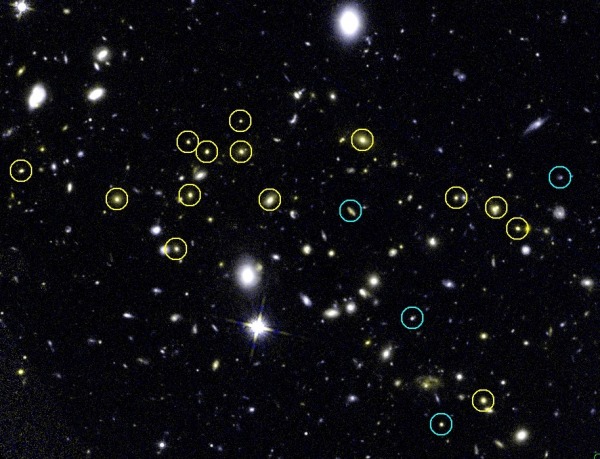We’ve Officially Found the Most Distant Galaxy Cluster From Us (So Far)
And we thought it was a long road down to the chemist's!

Space is big. Really, really big. You won’t believe how vastly, mind-bogglingly big it is. What, you want figures and numbers and stuff? Try 9.9 billion light years long, at the very least. That’s how far away the most distant galaxy cluster is to us, according to new research.
The cluster in question, which is named JKCS 041 and was first discovered in 2006, was researched by a team from the Carnegie Institute for Science using observations from the Hubble Space Telescope. By splitting images (like the one above) of the cluster into different constituent colors using spectrography, the team was able to pin down 19 different galaxies in a tightly packed arrangement located 9.9 billion light years away from ours. For context, the Virgo Cluster, the 2000-galaxy strong cluster at the center of the Virgo Supercluster, is about 65 million light years away from us.
Because it takes so long for the light from this cluster to reach us, and because evenly spaced galaxies usually denote a recently formed cluster, astronomers believe that the images we see of the JKCS 041 galaxies depict them at only 1 billion years old—or one tenth their current age. A lot of these galaxies aren’t forming in the way we would expect them to form, either. The yellow circles in the image above denote galaxies in their quiescent phase, which have stopped forming new stars but continue to expand outwards. The blue circled galaxies continue to form new stars. As you can see, this means that most of the galaxies in the cluster were already dormant and fading out only a billion years into their life
Team leader Andrew Newman hopes that their research, which was published in The Astrophysical Journal, will continue to offer insights into how the early universe first formed. “Because JKCS 041 is the most-distant known cluster of its size, it gives us a unique opportunity to study these old galaxies in detail and better understand their origins,” he said in a statement.
(via Geek.com and EurekAlert, image via NASA)
- If the Moon was as close to the Earth as the ISS is, we’d be in trouble
- MESSENGER snaps the highest-resolution photos of Mercury’s surface ever
- Why is Jupiter’s Red Spot shrinking?
Have a tip we should know? tips@themarysue.com